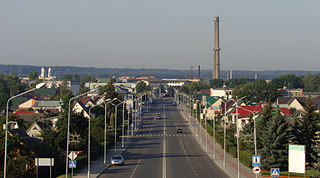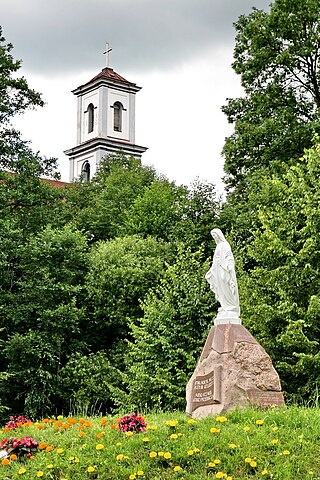
The Final Solution or the Final Solution to the Jewish Question was a Nazi plan for the genocide of individuals they defined as Jews during World War II. The "Final Solution to the Jewish question" was the official code name for the murder of all Jews within reach, which was not restricted to the European continent. This policy of deliberate and systematic genocide starting across German-occupied Europe was formulated in procedural and geopolitical terms by Nazi leadership in January 1942 at the Wannsee Conference held near Berlin, and culminated in the Holocaust, which saw the murder of 90% of Polish Jews, and two-thirds of the Jewish population of Europe.

Einsatzgruppen were Schutzstaffel (SS) paramilitary death squads of Nazi Germany that were responsible for mass murder, primarily by shooting, during World War II (1939–1945) in German-occupied Europe. The Einsatzgruppen had an integral role in the implementation of the so-called "Final Solution to the Jewish question" in territories conquered by Nazi Germany, and were involved in the murder of much of the intelligentsia and cultural elite of Poland, including members of the Catholic priesthood. Almost all of the people they murdered were civilians, beginning with the intelligentsia and swiftly progressing to Soviet political commissars, Jews, and Romani people, as well as actual or alleged partisans throughout Eastern Europe.

Franz Walter Stahlecker was commander of the SS security forces (Sicherheitspolizei and the Sicherheitsdienst for the Reichskommissariat Ostland in 1941–42. Stahlecker commanded Einsatzgruppe A, the most murderous of the four Einsatzgruppen active in German-occupied Eastern Europe. He was fatally wounded in action by Soviet partisans and was replaced by Heinz Jost.

Jonava is the ninth largest city in Lithuania with a population of c. 30,000. It is located in Kaunas County in central Lithuania, 30 km (19 mi) north east of Kaunas, the second-largest city in Lithuania. It is served by Kaunas International Airport. Achema, the largest fertilizer factory in the Baltic states, is located nearby. The city is sometimes called "the capital of midsummer holiday".
Marcinkonys or Marcinkańce Ghetto was a small Jewish ghetto established during the Holocaust in Marcinkonys. It existed from around November 1941 to November 1942 and housed 300 to 400 Jews.

Senda Berenson Abbott was a figure of women's basketball and the author of the first Basketball Guide for Women (1901–07). She was inducted into the Basketball Hall of Fame as a contributor on July 1, 1985, the International Jewish Sports Hall of Fame in 1987, and the Women's Basketball Hall of Fame in 1999.

The Slutsk affair refers to the massacre of thousands of Jews and others that occurred in Slutsk, Byelorussia in the Soviet Union, in October 1941, near the city of Minsk while under German occupation during World War II. The perpetrators were a combination of Gestapo special forces and Lithuanian allies of the Third Reich. Nearly 4,000 Jews were murdered over a two-day period along with thousands of non-Jews.

The Jäger Report, also Jaeger Report was written on 1 December 1941 by Karl Jäger, commander of Einsatzkommando 3, a death squad of Einsatzgruppe A attached to Army Group North in the Operation Barbarossa. It is the most detailed and precise surviving chronicle of the activities of one individual Einsatzkommando, and a key record documenting the Holocaust in Lithuania as well as in Latvia and Belarus.

Nemenčinė ( is a city in Vilnius district municipality, Lithuania, it is located only about 7 kilometres north-east of Vilnius. Close to Nemenčinė forest was planted which forms a sentence Žalgiris 600 visible from the air.

The Ponary massacre, or the Paneriai massacre, was the mass murder of up to 100,000 people, mostly Jews, Poles, and Russians, by German SD and SS and the Lithuanian Ypatingasis būrys killing squads, during World War II and the Holocaust in the Generalbezirk Litauen of Reichskommissariat Ostland. The murders took place between July 1941 and August 1944 near the railway station at Ponary, a suburb of today's Vilnius, Lithuania. 70,000 Jews were murdered at Ponary, along with up to 2,000 Poles, 8,000 Soviet POWs, most of them from nearby Vilnius, and its newly formed Vilna Ghetto. Along with 90 LTDF officers who refused to carry orders by the Germans after the Battle of Murowana Oszmianka.

The Kaunas pogrom was a massacre of Jews living in Kaunas, Lithuania, that took place on 25–29 June 1941; the first days of Operation Barbarossa and the Nazi occupation of Lithuania. The most infamous incident occurred at the garage of NKVD Kaunas section, a nationalized garage of Lietūkis, an event known as the Lietūkis Garage Massacre. There several dozen Jewish men, allegedly associates of NKVD, were publicly tortured and executed on 27 June in front of a crowd of Lithuanian men, women and children. The incident was documented by a German soldier who photographed the event as a man, nicknamed the "Death Dealer", beat each man to death with a metal bar. After June, systematic executions took place at various forts of the Kaunas Fortress, especially the Seventh and Ninth Fort.

The Holocaust in Lithuania resulted in the near total eradication of Lithuanian (Litvaks) and Polish Jews[a] in Generalbezirk Litauen of the Reichskommissariat Ostland in the Nazi-controlled Lithuania. Of approximately 208,000–210,000 Jews at the time of the Nazi invasion, an estimated 190,000 to 195,000 were killed before the end of World War II, most of them between June and December 1941. More than 95% of Lithuania's Jewish population was murdered over the three-year German occupation, a more complete destruction than befell any other country in the Holocaust. Historians attribute this to the massive collaboration in the genocide by the non-Jewish local paramilitaries, though the reasons for this collaboration are still debated. The Holocaust resulted in the largest loss of life in so short a period of time in the history of Lithuania.

The Rumbula massacre is a collective term for incidents on November 30 and December 8, 1941, in which about 25,000 Jews were murdered in or on the way to Rumbula forest near Riga, Latvia, during World War II. Except for the Babi Yar massacre in Ukraine, this was the biggest two-day Holocaust atrocity until the operation of the death camps. About 24,000 of the victims were Latvian Jews from the Riga Ghetto and approximately 1,000 were German Jews transported to the forest by train. The Rumbula massacre was carried out by the Nazi Einsatzgruppe A with the help of local collaborators of the Arajs Kommando, with support from other such Latvian auxiliaries. In charge of the operation was Höherer SS und Polizeiführer Friedrich Jeckeln, who had previously overseen similar massacres in Ukraine. Rudolf Lange, who later participated in the Wannsee Conference, also took part in organizing the massacre. Some of the accusations against Latvian Herberts Cukurs are related to the clearing of the Riga Ghetto by the Arajs Kommando. The Rumbula killings, together with many others, formed the basis of the post-World War II Einsatzgruppen trial where a number of Einsatzgruppen commanders were found guilty of crimes against humanity.
The Holocaust in Belarus refers to the systematic extermination of Jews living in the Byelorussian Soviet Socialist Republic during its occupation by Nazi Germany in World War II. It is estimated that roughly 800,000 Belarusian Jews were murdered during the Holocaust. However, other estimates place the number of Jews killed between 500,000 and 550,000.

The Holocaust in Latvia refers to the crimes against humanity committed by Nazi Germany and collaborators victimizing Jews during the occupation of Latvia. From 1941 to 1944, around 70,000 Jews were murdered, approximately three-quarters of the pre-war total of 93,000. In addition, thousands of German and Austrian Jews were deported to the Riga Ghetto.
RollkommandoHamann was a small mobile unit that committed mass murders of Lithuanian Jews in the countryside in July–October 1941, with an estimated death toll of at least 60,000 Jews. The unit was also responsible for many murders in Latvia from July through August 1941. At the end of 1941 the destruction of Lithuanian Jewry was effectively accomplished by Hamann's unit in the countryside, by the Ypatingasis būrys in the Ponary massacre, and by the Tautinio Darbo Apsaugos Batalionas (TDA) in the Ninth Fort in Kaunas. In about six months an estimated 80% of all Lithuanian Jews were killed. The remaining few were spared for use as a labor force and concentrated in urban ghettos, mainly the Vilna and Kaunas Ghettos.
The Jelgava massacres were the killing of the Jewish population of the city of Jelgava, Latvia that occurred in the second half of July or in early August 1941. The murders were carried out by German police units under the command of Alfred Becu, with a significant contribution by Latvian auxiliary police organized by Mārtiņš Vagulāns.
The Ninth Fort massacres of November 1941 were two separate mass shootings of 4,934 German Jews in the Ninth Fort near Kaunas, Lithuania. These were the first systematic mass killings of German Jews during the Holocaust. The question of where these killings fit into the development of the Final Solution is a matter of dispute among historians.

The Einsatzgruppen Operational Situation Reports (OSRs), or ERM for the German: Die Ereignismeldung UdSSR, were dispatches of the Nazi death squads (Einsatzgruppen), which documented the progress of the Holocaust behind the German–Soviet frontier in the course of Operation Barbarossa, during World War II. The extant reports were sent between June 1941 and April 1942 to the Chief of the Security Police and the SD in Berlin, from the occupied eastern territories including modern-day Poland, Belarus, Ukraine, Russia, Moldova, and the Baltic Countries. During the Nuremberg War Crimes Trials the originals were grouped according to year and month and catalogued using a consecutive numbering system, as listed in the below table. The original photostats are held at the National Archives in Washington D.C.
Helmut Krausnick was a German historian and writer. From 1959 to 1972, he was the head of the Institute of Contemporary History, a leading German research institute on the history of National Socialism.



















